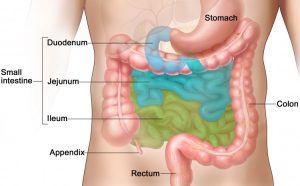What does the small bowel do? (5 functions)
In this article we will describe what does the small bowel do. Let’s start with some basics.

What is the small bowel?
The small bowel, also known as the small intestine, is a crucial part of the digestive system in humans and many other animals.
Its primary function is to facilitate the digestion and absorption of nutrients from the food we consume. The small bowel is a long, coiled tube located between the stomach and the large bowel (intestine). It has has three parts: the duodenum, jejunum, and ileum.
The small bowel is about 22 feet (more than 3x your height), and one inch wide. Whereas the large bowel is 6 feet long and three inches.
Here are the 5 key functions of the small bowel.
1. Digestion – the small bowel receives partially digested food from the stomach. It continues the process of digestion by breaking down complex molecules into smaller, more easily absorbed forms. The small bowel produces various enzymes, such as amylase, proteases, and lipases, which help break down carbohydrates, proteins, and fats, respectively.
2. Absorption of nutrients – the inner lining of the small bowel is covered with finger-like projections called villi, which increase the surface area available for absorption. Nutrients, such as carbohydrates, proteins, fats, vitamins, and minerals, are absorbed through the walls of the small bowel into the bloodstream. These nutrients are then transported to different cells and organs throughout the body to support various bodily functions.
3. Absorption of water – the small bowel also plays a role in absorbing water and electrolytes from the digested material, helping to maintain the body’s hydration and electrolyte balance.
4. Secretion – the small bowel secretes various substances, including mucus, enzymes, and hormones, to aid in digestion and regulate its own functions. For example, the hormone secretin, released by the small bowel, helps regulate the pH level in the digestive system and stimulates the release of pancreatic enzymes.
5. Transit – peristalsis, a coordinated muscular contraction, propels the partially digested food along the length of the small bowel. This movement allows for adequate digestion and absorption of nutrients.
Overall, the small bowel plays a critical role in breaking down food, absorbing nutrients and water, and facilitating the transfer of these substances to the bloodstream for use by the body.
Summary
We have described what does the small bowel do, and its 5 functions. We hope it is clearer now.
Other resources
These are other related articles.
What does the large bowel do?
What does the gastrointestinal tract do?
What does the liver do? (8 functions)
Last Reviewed on 7 March 2024
